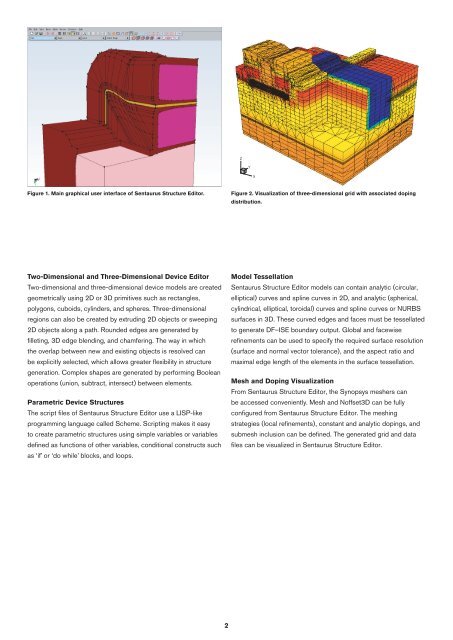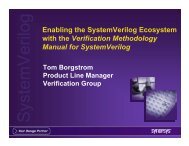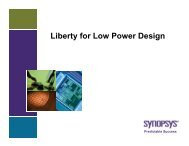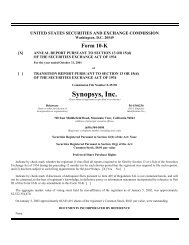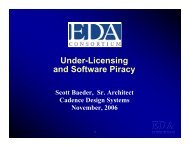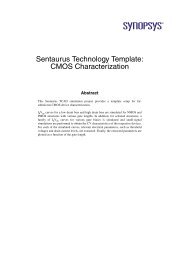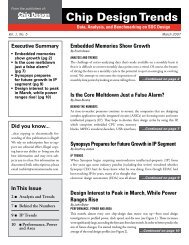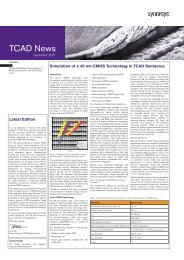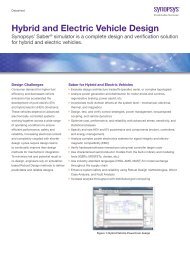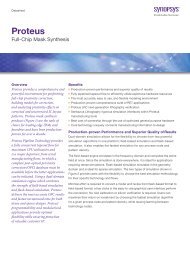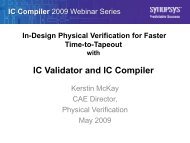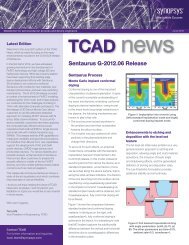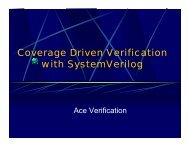Sentaurus Structure Editor Device Editor and ... - Synopsys.com
Sentaurus Structure Editor Device Editor and ... - Synopsys.com
Sentaurus Structure Editor Device Editor and ... - Synopsys.com
You also want an ePaper? Increase the reach of your titles
YUMPU automatically turns print PDFs into web optimized ePapers that Google loves.
Z<br />
Y<br />
X<br />
Figure 1. Main graphical user interface of <strong>Sentaurus</strong> <strong>Structure</strong> <strong>Editor</strong>.<br />
Figure 2. Visualization of three-dimensional grid with associated doping<br />
distribution.<br />
Two-Dimensional <strong>and</strong> Three-Dimensional <strong>Device</strong> <strong>Editor</strong><br />
Two-dimensional <strong>and</strong> three-dimensional device models are created<br />
geometrically using 2D or 3D primitives such as rectangles,<br />
polygons, cuboids, cylinders, <strong>and</strong> spheres. Three-dimensional<br />
regions can also be created by extruding 2D objects or sweeping<br />
2D objects along a path. Rounded edges are generated by<br />
filleting, 3D edge blending, <strong>and</strong> chamfering. The way in which<br />
the overlap between new <strong>and</strong> existing objects is resolved can<br />
be explicitly selected, which allows greater flexibility in structure<br />
generation. Complex shapes are generated by performing Boolean<br />
operations (union, subtract, intersect) between elements.<br />
Parametric <strong>Device</strong> <strong>Structure</strong>s<br />
The script files of <strong>Sentaurus</strong> <strong>Structure</strong> <strong>Editor</strong> use a LISP-like<br />
programming language called Scheme. Scripting makes it easy<br />
to create parametric structures using simple variables or variables<br />
defined as functions of other variables, conditional constructs such<br />
as ‘if’ or ‘do while’ blocks, <strong>and</strong> loops.<br />
Model Tessellation<br />
<strong>Sentaurus</strong> <strong>Structure</strong> <strong>Editor</strong> models can contain analytic (circular,<br />
elliptical) curves <strong>and</strong> spline curves in 2D, <strong>and</strong> analytic (spherical,<br />
cylindrical, elliptical, toroidal) curves <strong>and</strong> spline curves or NURBS<br />
surfaces in 3D. These curved edges <strong>and</strong> faces must be tessellated<br />
to generate DF–ISE boundary output. Global <strong>and</strong> facewise<br />
refinements can be used to specify the required surface resolution<br />
(surface <strong>and</strong> normal vector tolerance), <strong>and</strong> the aspect ratio <strong>and</strong><br />
maximal edge length of the elements in the surface tessellation.<br />
Mesh <strong>and</strong> Doping Visualization<br />
From <strong>Sentaurus</strong> <strong>Structure</strong> <strong>Editor</strong>, the <strong>Synopsys</strong> meshers can<br />
be accessed conveniently. Mesh <strong>and</strong> Noffset3D can be fully<br />
configured from <strong>Sentaurus</strong> <strong>Structure</strong> <strong>Editor</strong>. The meshing<br />
strategies (local refinements), constant <strong>and</strong> analytic dopings, <strong>and</strong><br />
submesh inclusion can be defined. The generated grid <strong>and</strong> data<br />
files can be visualized in <strong>Sentaurus</strong> <strong>Structure</strong> <strong>Editor</strong>.<br />
2


